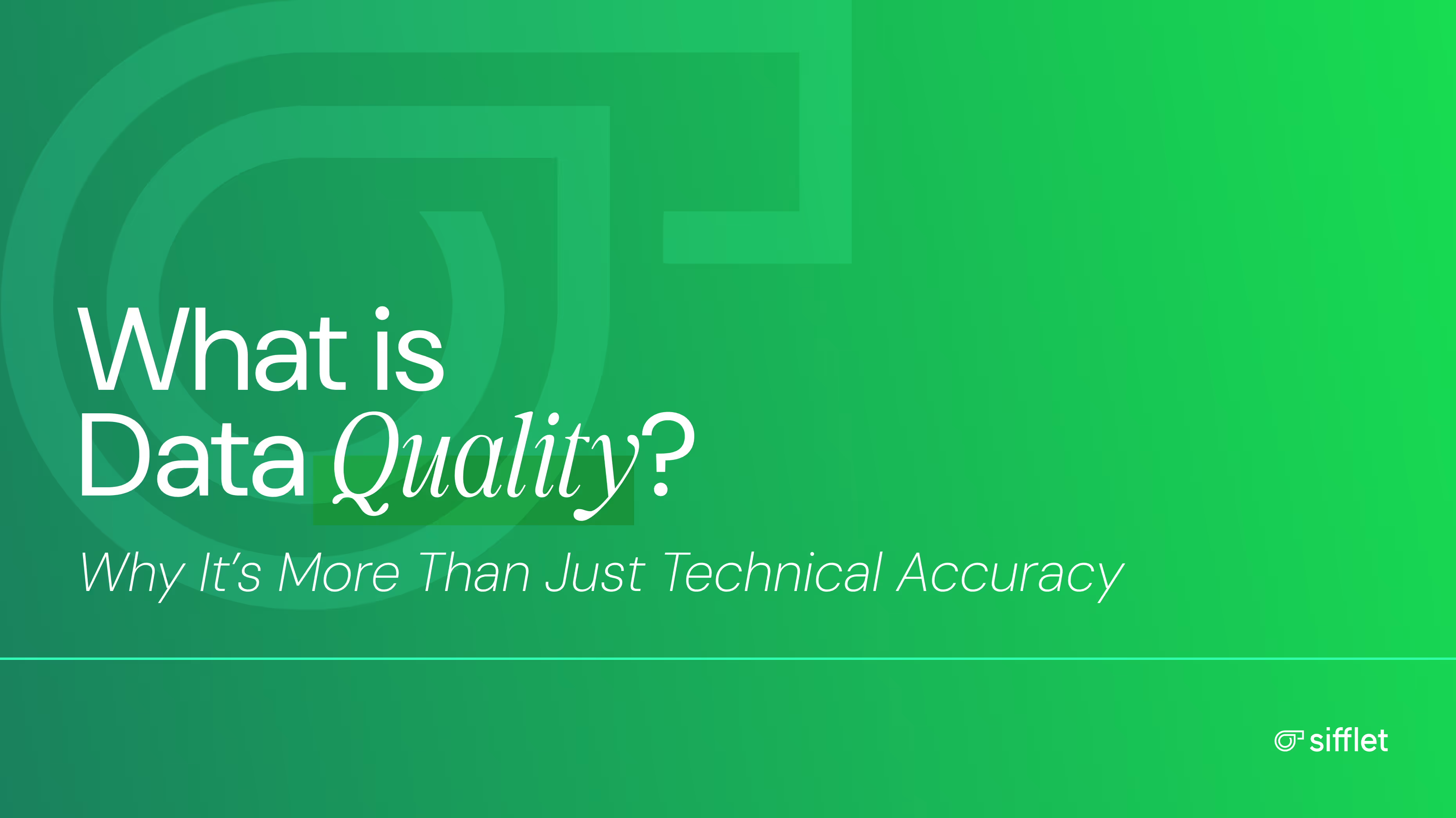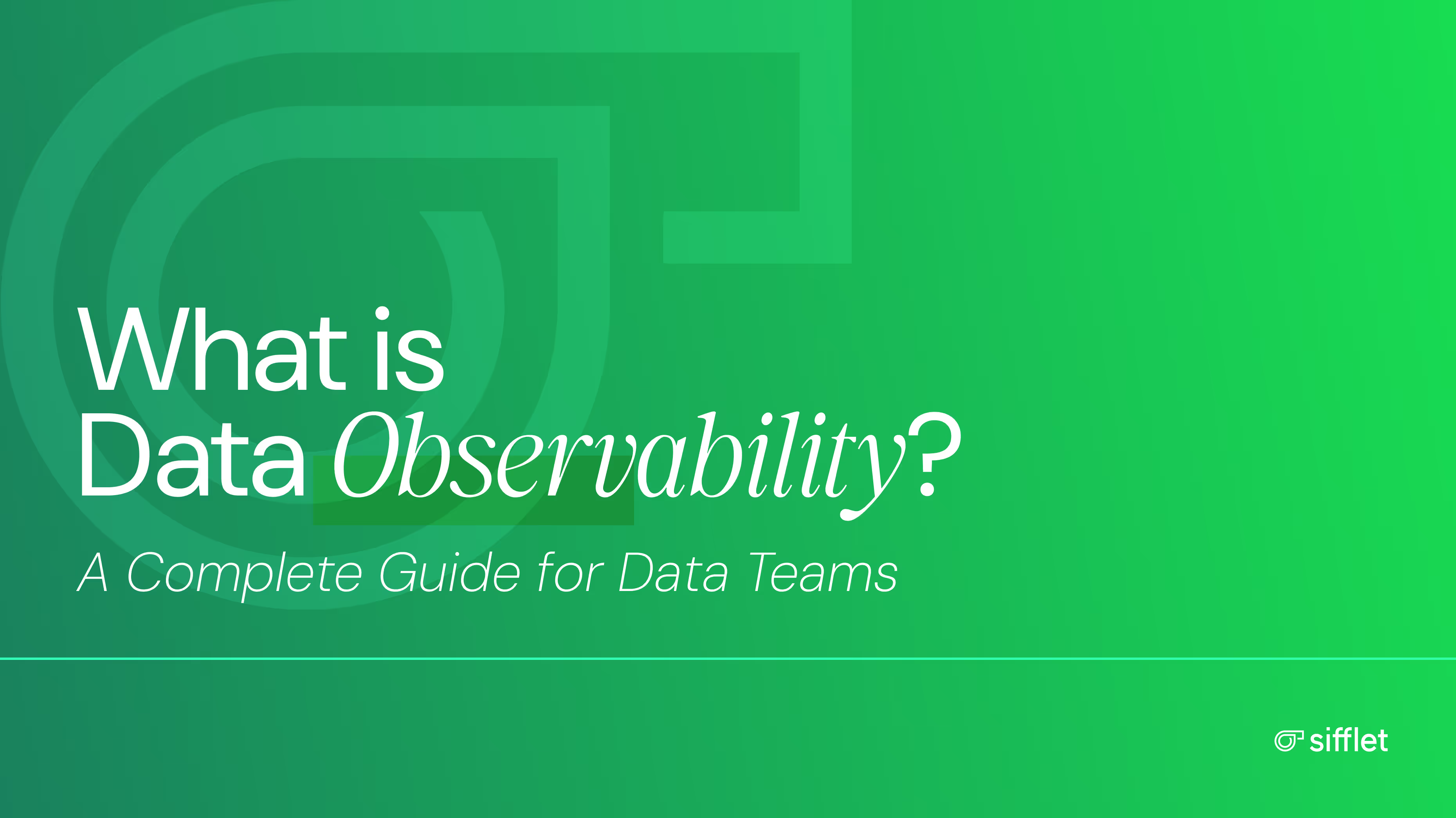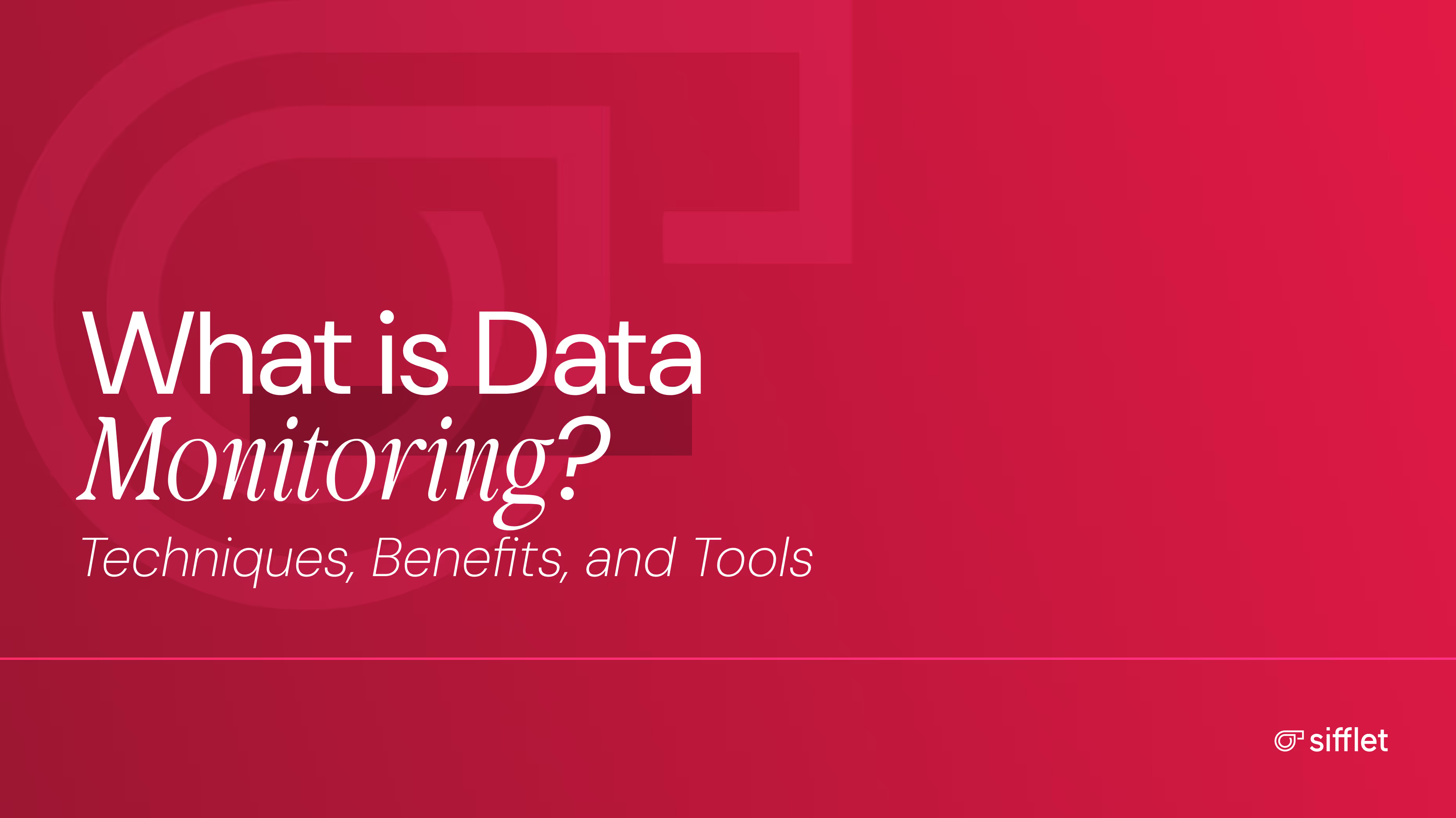Definition: Data quality defines whether or not your data is fit for its intended business use. There are two lenses to data quality: technical quality and business quality. Technical quality looks at criteria such as accuracy, volume, and freshness, while business quality looks to ensure that data is aligned with how the business runs and defines “correct.”
Understanding Data Quality
When businesses talk about data quality, they’re really asking a fundamental question: can we trust this data? This is a particularly important when it comes to:
- Analytics: Can we make the decisions that matter, like allocating marketing campaign spend, based on accurate insights?
- Data Products: Can the data power technologies, like a recommendation engine to suggest products to customers on e-commerce websites, to boost sales and revenue?
- Generative AI: Do we have high-quality data inputs to train a model for specific use-cases?
It’s not just about having clean spreadsheets or error-free data bases, its about whether your data actually serves the business purposes you need it to serve. Much like ingredients in a restaurant kitchen, even the freshest vegetables won’t help if they’re the wrong ingredient for a dish you’re trying to make.
Example
At a rapidly growing SaaS company, the customer success team relies on health scores to identify accounts at risk of churning, but lately, something feels off. Data shows that several “high risk” accounts just renewed their contracts, while accounts marked as “healthy” have been cancelling without warning.
As the Head of Customer Success, you dig deeper with the data engineering team and run into data quality issues. On the technical side, you notice that your customer engagement data is lagging by three days and usage metrics that should flag declining activity aren’t surfacing until it’s too late. Customer support ticket data is also inconsistent. Some issues are categorized as “billing” in one system and “payment” in another. This makes it impossible to track trends accurately.
Business quality problems run much deeper, however. Your health score algorithm was built when most customers were small startups, but now 60% of your revenue comes from enterprise clients who use the product differently. The scoring model still penalizes enterprise accounts for having fewer daily active users, even though that's normal for their business model. Meanwhile, your sales team defines "active usage" differently than your product team, creating confusion about which accounts are truly engaged.
You hit pause to fix both dimensions:
- Technical: the team implements real-time data pipelines and standardizes definitions
- Business: the health score model is rebuilt to reflect your current customer base
Six months later, your churn predictions are 40% more accurate, and your customer success team can focus their efforts on accounts that truly need attention.
The result? A 15% reduction in churn and a customer success team that trusts their data enough to act on it confidently.
Takeaway
When teams work with high data quality, your company gains a competitive edge. Without it, it might be spending money and time needlessly on clean up and damage control.
In short, your data stack is only as powerful as the quality of the data flowing through it.
What is Data Quality?
Data quality defines whether or not your data is fit for its intended business use.
It operates through two essential lenses that work together: Technical quality and business quality.
Technical quality focuses on the measurable characteristics of your data, such as accuracy, completeness, freshness and consistency.
This is sometimes called the “technical metadata” (or data about your data) and it covers the nuts and bolts: Are customer email addresses formatted correctly? Do you have sales figures for every region? Is yesterday’s revenue data available this morning?
Meanwhile, business quality asks whether your data aligns with how your organization actually runs and defines success.
Revenue numbers might be technically perfect but if they don’t account for returns, are measured at the wrong time in your sales cycle, or conflict with how your finance team calculates performance, then they’re not business-aligned.
If data quality breaks down, whether from technical issues or business misalignment, the costs compound quickly.
Teams waste time investigating discrepancies, leaders make decisions based on unreliable information, and customer experiences suffer when systems act on bad data. But when organizations get data quality right, they create a foundation for faster decision-making, more reliable automation, and the confidence to act on insights rather than second-guess them.
Data Quality vs. Data Monitoring
Data quality and data monitoring are closely related but serve different purposes in the data ecosystem.
Data quality is about the state of your data and determining if its fit for its intended business use. It’s the “what” question:
- What condition is my data in?
- Is it accurate, complete, timely, and aligned with business needs?
Data quality is both an outcome you're trying to achieve and a set of standards you're measuring against.
Data monitoring, on the other hand, is the process of watching your data to ensure it maintains quality over time:
- How do I know if and when my data quality is degrading?
- How do I catch problems before they impact business decisions?
Data monitoring is the system of checks, alerts, and ongoing surveillance that helps to maintain your data quality.
A good metaphor is car maintenance: data quality is whether your car runs well, gets good gas mileage, and gets you where you need to go safely. Data monitoring is the dashboard that shows the engine’s temperature, oil pressure, and fuel level… plus the warning lights that alert you when something’s wrong!
Data monitoring is a key tool to keep a healthy data quality.
Better data collection processes, cleaner ETL pipelines, or more rigorous data governance can help improve data quality, but without monitoring, you’re still flying blind. You won’t know when data quality issues emerge until they’ve already caused problems downstream.
Data Quality vs. Data Integrity
There is a fine nuanced distinction between data quality and data integrity that often gets blurred in practice, but there are meaningful differences.
Data integrity is a more narrow concept that focuses on the structural and logical consistency of your data.
Data integrity ensures your data follows the rules and constraints that define its structure, such as making sure every customer record has a unique ID, that foreign keys point to valid records, or that dates fall within reasonable ranges.
In this sense, data integrity focuses on the technical correctness of how data is stored and connected.
Data quality, however, is a broader concept, it focuses on whether your data is fit for its intended business purpose.
For that reason, data integrity is one component of data quality, but quality goes further to include things like completeness, freshness, and business relevance.
The catch? Data can have perfect integrity but still be poor quality if its outdated, missing key fields, or doesn’t align with business definitions.
A good metaphor here is building construction.
Data integrity is like making sure the foundation is structurally sound, the electrical wiring meets code, and the plumbing doesn't leak. Data quality is like asking whether the building actually serves its intended purpose: is it comfortable, functional, and suitable for the people who need to use it?
In other words, data integrity is a prerequisite for data quality, but it's not sufficient. You can't have high-quality data without good integrity, but you can have technically sound data that's still not fit for business use.
Data Quality Characteristics and Dimensions
Data quality characteristics (sometimes called “dimensions”) are standardized attributes to assess how “good” your data is for its intended use.
These dimensions apply across industries and help companies evaluate, benchmark, and improve their data quality from a technical perspective and business perspective.
Here are the most widely recognized data quality dimensions, with brief definitions and examples:
Great data isn’t just clean. It’s credible, current, and business-aligned.
How Data Teams Establish Data Quality Metrics
Establishing meaningful data quality metrics isn’t just about picking the right numbers to track.It’s about creating a systematic approach that connects technical measurements to business outcomes.
The most effective data teams don’t start with metrics. Instead, they start with understanding what “good” data looks like for their specific use cases, then work backwards to define measurable standards. Data governance frameworks provide a solid foundation to establish metrics because they define:
- who has authority over which data definitions
- how standards get set
- what processes teams follow when quality issues arise
When your marketing team defines “active customer” differently than your product team, a strong governance framework ensures that there’s a clear process for resolving that conflict and creating a single source of truth.
Governance frameworks also establish the business context that makes metrics meaningful, connecting technical measurements such as “completeness percentage” to business impacts like “revenue at risk from incomplete customer records.”
Data stewards also play a crucial role in translating between business needs and technical implementation. They're the bridge between business stakeholders who know what data should represent and data engineers who understand what's technically feasible to measure.
They also serve as the escalation point when quality issues arise, helping teams understand whether a data anomaly represents a real business problem or a technical glitch that can be safely ignored.
Collaboration across roles is essential because data quality means different things to different people.
A data engineer might focus on technical metrics like schema compliance and pipeline reliability, while a business analyst cares more about whether the data supports accurate reporting and decision-making.
The most successful teams establish metrics that serve multiple perspectives, creating shared accountability rather than siloed ownership.
However, traditional data quality metrics are increasingly insufficient for modern data environments.
Static rules about completeness, accuracy, and consistency don't capture the dynamic nature of how data flows through complex systems, how upstream changes ripple through downstream applications, or how data quality issues in one system can cascade across an entire data stack. This is why many organizations are moving beyond traditional data quality monitoring toward full stack data observability, like Sifflet, which provides a holistic view of data health across every layer of the data infrastructure, from ingestion to consumption.
Final Thoughts
Data quality is no longer just a technical concern, it's a business imperative that requires both technical precision and business alignment.
The organizations that will thrive are those that recognize data quality as a foundational element of their broader data strategy, not an afterthought.
If you're still relying on basic completeness checks and manual data validation, it's time to evaluate how well your current approach serves your business needs.
Consider how full stack data observability solutions like Sifflet can provide the comprehensive visibility you need to maintain data quality across your entire data infrastructure, giving you the confidence to act on your data rather than constantly question it.
Frequently Asked Questions
How Can I Measure Data Quality?
Start with the data quality dimensions that matter most to your business, such as accuracy, completeness, timeliness, and consistency.
Additionally, implement automated tools to track these metrics continuously rather than relying on manual spot checks.
Another key is to connect technical measurements (like "95% completeness") to business impact ("missing customer addresses affect 20% of shipments").
Modern data observability platforms like Sifflet can automate this measurement across your entire data stack.
How Can I Improve Data Quality?
Focus on prevention, not just detection.
Make sure to implement data validation at ingestion points, standardize definitions across teams through governance frameworks, and establish clear ownership with data stewards.
Addressing both technical issues (like pipeline monitoring) and business alignment (ensuring data definitions match how teams actually work) is critical. The most effective approach combines automated monitoring with cross-functional collaboration between data engineers, analysts, and business users.
What is Data Quality Management?
Data quality management is the ongoing process of defining, measuring, monitoring, and improving data quality across your organization.
It includes establishing governance frameworks, assigning data stewardship roles, implementing technical controls, and creating processes for resolving quality issues. Rather than a one-time project, it's a continuous practice that evolves with your business needs and data infrastructure.
Effective data quality management treats quality as a shared responsibility, not just an IT concern.
Is There a Tool that Helps Automate Data Quality Monitoring?
Yes.
Modern data observability platforms like Sifflet automate data quality checks across your pipelines.
Instead of relying on manual rules or reactive alerts, these tools continuously monitor freshness, volume, schema changes, and more, helping you catch and resolve issues before they impact the business.
How Can I Ensure Both Technical and Business Data Quality?
It’s not enough to monitor just the technical side of data (like schema or freshness).
Tools like Sifflet bridge the gap between technical and business context by mapping quality issues to business impact. This helps teams prioritize what matters most: data that directly supports decision-making, data products and operations.





















-p-500.png)
